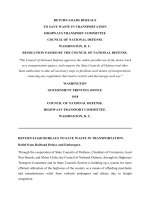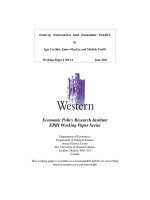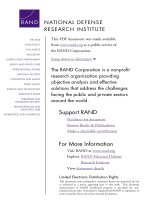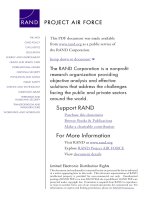National Defense research institute pot
Bạn đang xem bản rút gọn của tài liệu. Xem và tải ngay bản đầy đủ của tài liệu tại đây (2.66 MB, 457 trang )
THE ARTS
This PDF document was made available
CHILD POLICY
from www.rand.org as a public service of
CIVIL JUSTICE
the RAND Corporation.
EDUCATION
ENERGY AND ENVIRONMENT
Jump down to document6
HEALTH AND HEALTH CARE
INTERNATIONAL AFFAIRS
NATIONAL SECURITY
POPULATION AND AGING
PUBLIC SAFETY
SCIENCE AND TECHNOLOGY
SUBSTANCE ABUSE
TERRORISM AND
HOMELAND SECURITY
TRANSPORTATION AND
INFRASTRUCTURE
WORKFORCE AND WORKPLACE
The RAND Corporation is a nonprofit
research organization providing
objective analysis and effective
solutions that address the challenges
facing the public and private sectors
around the world.
Support RAND
Purchase this document
Browse Books & Publications
Make a charitable contribution
For More Information
Visit RAND at www.rand.org
Explore RAND National Defense
Research Institute
View document details
Limited Electronic Distribution Rights
This document and trademark(s) contained herein are protected by law
as indicated in a notice appearing later in this work. This electronic
representation of RAND intellectual property is provided for noncommercial use only. Permission is required from RAND to reproduce, or
reuse in another form, any of our research documents.
This product is part of the RAND Corporation monograph series.
RAND monographs present major research findings that address the
challenges facing the public and private sectors. All RAND monographs undergo rigorous peer review to ensure high standards for
research quality and objectivity.
Map of Afghanistan
Preface
The attacks carried out against the United States by radical Islamist
fanatics on September 11, 2001, almost instantly thrust the nation
into a no-notice war on terror. This sudden showdown against a
shadowy but determined foe placed a heightened demand on virtually
every resource at the disposal of the new administration of President
George W. Bush. The principal ingredients of that war would consist
not only of traditional military moves but also of expanded homeland
security measures, diplomatic initiatives, efforts to find and embargo
enemy sources of financing, and covert intelligence operations. Although the war’s initial focus was directed against the immediate perpetrators of the attacks—Osama bin Laden and his al Qaeda terrorist
organization—the Bush administration swore that it ultimately
would bring pressure to bear not only on that and other terrorist
movements around the world but also on state leaders who harbored
them.
This book assesses the planning and initial execution of Operation Enduring Freedom, the first U.S. response to the terrorist
attacks of September 11 against al Qaeda’s center of gravity in Afghanistan and against the Taliban theocracy that provided it safe haven. Since that campaign was largely an air war enabled by U.S. and
allied special forces and indigenous Afghan opposition groups, the
report focuses predominantly on the air portion of the joint and
combined operations that were conducted in Afghanistan from October 7, 2001, through March 2002 by U.S. Central Command
(CENTCOM). Its intent is to derive insights of a strategic and opera-
v
vi
Air Power Against Terror: America’s Conduct of Operation Enduring Freedom
tional nature that not only will be of practical use to U.S. defense
planners in and of themselves but also will offer a backdrop against
which to assess the more complex and demanding Operation Iraqi
Freedom that took place a year later to bring down the regime of
Saddam Hussein. Although unbeknown to its participants at the
time, Operation Enduring Freedom proved in many ways to have
been a dress rehearsal for the even more eventful campaign that soon
followed.
The research reported here should interest both uniformed officers in all services and civilian members of the defense establishment
concerned with strategy and force employment issues raised by the
war in Afghanistan. The research was conducted for U.S. Central
Command Air Forces (CENTAF) within the International Security
and Defense Policy Center of the RAND National Defense Research
Institute, a federally funded research and development center sponsored by the Office of the Secretary of Defense, the Joint Staff, the
unified commands, and the defense agencies.
For more information on RAND’s International Security and
Defense Policy Center, contact the director, James Dobbins. He can
be reached by email at ; by phone at (703)
413-1100 extension 5134; or by mail at the RAND Corporation,
1200 South Hayes Street, Arlington, Virginia 22202-5050. More information about RAND is available at www.rand.org.
Contents
Preface .......................................................................v
Figures ...................................................................... xi
Summary...................................................................xiii
Acknowledgments ........................................................xxxi
Abbreviations ............................................................ xxxv
CHAPTER ONE
Introduction .................................................................1
CHAPTER TWO
A Nation Girds for War ................................................... 13
Ensuring Homeland Air Defense .......................................... 18
Forming a Coalition ....................................................... 23
Shaping a Strategy ......................................................... 38
Crafting a Plan ............................................................. 49
The Buildup of Forces ..................................................... 62
CHAPTER THREE
The United States Strikes Back ........................................... 73
The Operational Setting ................................................... 75
Opening Moves ............................................................ 78
From Fixed to Fleeting Targets ............................................ 94
Closing Ranks with the Opposition Groups..............................103
The Campaign Hits a Slump .............................................105
vii
viii
Air Power Against Terror: America’s Conduct of Operation Enduring Freedom
The Allied Contribution ..................................................116
The Fall of Mazar-i-Sharif and Kabul ....................................119
CHAPTER FOUR
A Shift in Strategy ........................................................135
Hunting Down an Elusive Quarry .......................................138
Toward the Consolidation of Initial Gains ...............................144
The Battles of Tora Bora and Zhawar Kili ...............................149
The Final Rout of the Taliban ............................................154
CHAPTER FIVE
Operation Anaconda .....................................................163
Initial Planning ...........................................................164
A Troubled Start ..........................................................178
The Showdown at Roberts Ridge .........................................186
Recovering from the Initial Setbacks .....................................192
The Endgame of Enduring Freedom .....................................200
Anaconda Issues...........................................................204
Toward Better Air-Ground Coordination ................................221
CHAPTER SIX
Distinctive Aspects and Achievements ...................................247
Data Fusion Comes of Age ...............................................253
A New Air-Ground Synergy ..............................................258
Humanitarian Relief and Force Sustainment .............................263
Space Support to Force Employers .......................................274
CAOC Operations ........................................................280
The Buildup at Manas ....................................................285
New Technology Applications ............................................287
CHAPTER SEVEN
Problems in Execution ...................................................293
Early Tensions Between the CAOC and CENTCOM ...................295
The Impact of Rules-of-Engagement Constraints ........................311
The Trend Toward Centralized Execution ...............................324
Contents
ix
Integrating Other Government Agencies .................................330
The Costs of the High Operating Tempo ................................331
CHAPTER EIGHT
Conclusions...............................................................337
Innovations in Force Employment .......................................339
Persistent Problems in Need of Attention ................................343
On Balance................................................................357
Bibliography ..............................................................371
Figures
2.1.
3.1.
5.1.
5.2.
6.1.
6.2.
CENTCOM’s Area of Responsibility ............................ 63
Afghan Operating Area ........................................... 79
Operation Anaconda Planned Disposition of Forces ............178
Operation Anaconda Aircraft Stack .............................196
Strike Sorties Through December 2001 by Service..............248
Strike Sorties Through December 2001 by Aircraft Type .......249
xi
Summary
The terrorist attacks of September 11, 2001, caught the United States
and its leaders completely off guard. They also defined the face of
early 21st-century conflict by elevating radical Islamist terrorism to
the level of a core threat to U.S. security. The attacks were the boldest
hostile act to have been committed on U.S. soil since Pearl Harbor.
As such, they prompted a feeling of unity throughout United States
perhaps unmatched since the nation’s entry into World War II. Although no one immediately claimed responsibility for the attacks, the
U.S. government quickly determined that they were the work of the
wealthy Saudi Arabian exile, Osama bin Laden, and his al Qaeda terrorist network.
Even as the attacks were still under way, the alert status of U.S.
forces around the world was raised to Defense Condition
(DEFCON) 3, their highest alert level since the Yom Kippur War of
1973. Moves also were implemented to update plans for combat operations in the most likely areas of possible U.S. military involvement
around the world. Within minutes of having learned of the attacks,
U.S. commands throughout Europe, Asia, and the Middle East established crisis action teams to enforce heightened force-protection
measures and to assess the status of the forces in their respective areas
of responsibility that might be committed to action in the looming
war on terror.
In crafting a response to the attacks, the first challenge that the
Bush administration faced was building the broadest possible international coalition to lend material support and moral legitimacy to the
xiii
xiv
Air Power Against Terror: America’s Conduct of Operation Enduring Freedom
impending war. The second challenge entailed developing a concrete
strategy that defined and specified the campaign’s priorities and goals.
The third was to develop a detailed force-employment plan for
meeting those priorities and achieving the administration’s most immediate strategic goals. Finally, there was a need to begin fielding and
prepositioning the required combat and combat-support assets of all
U.S. services for any such action.
Before any of these initiatives could be put into motion, however, the Department of Defense first had to establish an air defense
umbrella over the United States to ensure against any further terrorist
use of aircraft as weapons. Before the September 11 attacks, the
United States had maintained only a token air defense posture consisting entirely of two Air National Guard fighters poised on roundthe-clock 15-minute alert at each of only seven bases along the nation’s coasts to protect American air sovereignty. Less than a day after
the attacks, however, the picture had changed dramatically, with dozens of armed fighters maintaining round-the-clock patrols over more
than 30 American cities. In addition, this greatly enhanced nationwide air defense posture, code-named Operation Noble Eagle, maintained an undisclosed number of armed fighters on alert at bases
throughout the United States.
Preparing for War
It soon became clear that the U.S. response to the September 11 attacks would consist not just of combat operations but also of diplomacy, coalition-building, heightened intelligence activities, immigration control, enhanced homeland defense, extensive police work, and
efforts to identify and embargo al Qaeda’s sources of funding. Yet
there was no doubt that the initial round would be an air-dominated
military offensive to take down bin Laden’s al Qaeda network in Afghanistan and that country’s ruling Taliban theocracy, which had
provided the terrorists safe haven. Within just a day of the attacks,
the Bush administration made determined moves to assemble a
broad-based international coalition before committing the nation to
Summary
xv
any military action. For its part, the North Atlantic Council invoked
the mutual defense clause in the charter of the North Atlantic Treaty
Organization (NATO) for the first time in the alliance’s 52-year history. The administration also garnered the support of numerous other
countries around the world, including Russia, and pressured Pakistan
to provide whatever intelligence and logistical support might be
needed to help capture or kill al Qaeda’s leaders and assist the United
States in retaliating against any countries that may have supported
them. Shortly thereafter, Pakistan agreed to open its airspace for the
transit of any U.S. air attacks against the Taliban and al Qaeda and to
halt the flow of fuel and supplies from Pakistan to Afghanistan.
On the domestic front, Congress promptly granted the administration a $40 billion emergency funding package for conducting
counterterrorist operations, with a provision for an immediate release
of $10 billion for the White House to use at its discretion. Congress
also moved quickly to empower President Bush to take action against
the terrorists by issuing a joint resolution that released the White
House from any obligation to seek a formal declaration of war in the
course of pursuing its options. Within days of the terrorist attacks,
the Senate passed a 98–0 resolution authorizing the use of all necessary and appropriate force. Shortly thereafter, the House of Representatives passed a similar resolution by a vote of 420–1.
Next, the administration began building a strategy for carrying
out a phased response to the terrorist attacks, starting with a war focused on al Qaeda and the Taliban in Afghanistan but eventually
reaching beyond to terrorist movements worldwide with the global
reach to harm the United States. At the time of the September 11
attacks, there was no plan in existence for U.S. military action in Afghanistan. Yet in the span of just three weeks, the government pulled
together an effective coalition, crafted the beginnings of a serviceable
strategy, moved needed forces and materiel to the region, made alliances with indigenous anti-Taliban elements in Afghanistan, laid the
groundwork for an acceptable target-approval process, and prepared
to conduct concurrent humanitarian relief operations.
To facilitate the impending war, the Bush administration sought
and gained the approval of the Saudi government for the use of the
xvi
Air Power Against Terror: America’s Conduct of Operation Enduring Freedom
Combined Air Operations Center (CAOC) maintained by the air
component of U.S. Central Command (CENTCOM) at Prince Sultan Air Base in Saudi Arabia. Support also was gained from several
former Soviet republics in Central Asia for the temporary basing of
U.S. aircraft and military personnel slated to conduct combat operations against Afghanistan. A key element of this planning was a determination by the administration to avoid causing any harm to Afghan noncombatants so as to avoid further inflaming anti-American
passions throughout the Islamic world. The war plan that emerged
accordingly sought to rely to the fullest extent possible on precisionguided weapons.
The United States Strikes Back
On October 7, 2001, CENTCOM commenced Operation Enduring
Freedom, a joint and combined war against al Qaeda and the Taliban
in Afghanistan. The campaign began at night with strikes against 31
targets, including early warning radars, ground forces, command-andcontrol facilities, al Qaeda infrastructure, and Taliban airfields. Attacks on the second day also began during the hours of darkness but
continued this time into daylight, indicating a determination by
CENTCOM that the Taliban’s air defenses had been largely negated.
During the fifth consecutive day of bombing, mountain cave complexes harboring al Qaeda combatants and equipment were attacked
for the first time. After the tenth day, the target list was greatly expanded and discrete engagement zones were established throughout
the country to facilitate aerial attacks against Taliban and al Qaeda
forces. Although these engagement zones were similar to the kill
boxes that had been set up during Operation Desert Storm a decade
earlier, they did not allow allied aircrews to attack anything that
moved inside them without prior CENTCOM approval because of
persistent uncertainties regarding the location of friendly Afghan opposition forces and allied special operations forces (SOF) in close
proximity to known or suspected enemy positions. Nevertheless, their
Summary
xvii
establishment did indicate an impending move away from preplanned
targets toward pop-up targets of opportunity as they emerged.
The successful insertion of a small number of U.S. SOF teams
into Afghanistan after 11 days of bombing signaled the onset of a new
use of air power in joint warfare, in which Air Force terminal attack
controllers working with SOF spotters positioned forward within line
of sight of enemy force concentrations directed precision air attacks
against enemy ground troops who were not in direct contact with
friendly forces. In this phase of operations, airborne forward air controllers also identified enemy targets and cleared other aircraft to attack them. Thanks to the reduced enemy air defense threat, U.S. aircraft were now cleared to descend to lower altitudes as necessary to
attack any emerging targets that were observed to be on the move.
By late October, however, a sense of frustration had begun to
settle in among some observers as the war’s level of effort averaged
only around 63 strike sorties a day, with continuing attacks against
fixed enemy military assets and relatively little apparent damage being
done to Taliban troop strength. In light of this seeming lack of progress, a growing number of critics began predicting either a quagmire
or an outright U.S. failure. These voices of concern naturally put the
Bush administration on the defensive in its effort to refute allegations
that the campaign had bogged down.
In fairness to the administration, there remained a lack of much
actionable intelligence on elusive targets at that still-early stage of the
war, and the nearness of friendly indigenous Afghan Northern Alliance forces to Taliban front lines created a constant danger that those
forces might get hit by errant bombs. Moreover, although the opportunity for U.S. cooperation with the Northern Alliance had been
available and ready to be exploited in principle from the very start of
the campaign, CENTCOM was slow to insert SOF teams into Afghanistan to empower the opposition groups because of persistent
bad weather. Even after the tenth day of U.S. combat involvement,
the latest of CENTCOM’s several efforts to insert the first SOF unit
had to be aborted at the last minute because of conditions that prohibited safe helicopter operations.
xviii
Air Power Against Terror: America’s Conduct of Operation Enduring Freedom
Finally, on October 19, two Air Force Special Operations
Command (AFSOC) MH-53J Pave Low helicopters successfully delivered Army Special Forces Operational Detachment Alpha 555
(more commonly known as A-Team 555) to a landing zone in Afghanistan’s Shamali plains, which had been marked by a Central Intelligence Agency (CIA) team that was already in place and awaiting
its military compatriots. These Army SOF troops, with their attached
Air Force terminal attack controllers, would provide the first eyes on
target for enabling what eventually became a remarkably successful
U.S. exercise in air-ground cooperation.
The Rout of the Taliban
On October 21, Northern Alliance forces began marshaling for an
attack on Mazar-i-Sharif, with a view toward eventually moving from
there on to Kabul. Two days later, the most intense ground fighting
since the start of Enduring Freedom occurred as Northern Alliance
and Taliban forces exchanged heavy fire. The Northern Alliance
aimed at hastening the Taliban’s collapse by striking from all sides.
U.S. cooperation enabled the application of opposition-group pressure in the north, while U.S. SOF units sought to organize similar
pressure in the south against Kandahar.
The Northern Alliance’s full-up offensive commenced on October 28. That day saw ramped-up U.S. air attacks against Taliban artillery positions that were threatening a Northern Alliance supply
line. With the intensified use of B-1Bs and B-52s against the Taliban
front lines, Northern Alliance leaders who once criticized the bombing now came to praise it and to draw increased hopes of achieving
success. The A-Teams were now calling in heavy air attacks against
the Taliban’s two circles of defensive trenches around Mazar-i-Sharif.
Enemy supply lines and communications were cut, hundreds of enemy vehicles and bunkers were destroyed, and thousands of Taliban
fighters were either captured or killed or else escaped.
On November 9, Northern Alliance forces took Mazar-i-Sharif.
That success was the first tangible victory in Enduring Freedom. Two
Summary
xix
days later, the Northern Alliance surged against Taliban forces defending Kabul. Then, on November 13, Northern Alliance forces
captured Kabul as Taliban forces beat a retreat, creating a strategic
breakthrough that silenced critics of the operation who, for a time,
had voiced concerns about an impending quagmire.
The capture of Mazar-i-Sharif and Kabul by the Northern Alliance, enabled decisively by American air power working in close harmony with allied SOF teams, was a major breakthrough. Thanks to
the rapid accumulation of advances that had been achieved in such
short order, the resistance now controlled nearly three-quarters of the
country, as contrasted with only 10 percent in the northernmost
reaches before the start of the campaign just a few weeks before. With
the fall of Mazar-i-Sharif and Kabul, the Taliban suffered a major
loss, and al Qaeda forces in Afghanistan were clearly on the run. Although a substantial number of al Qaeda and Taliban combatants
succeeded in eluding the campaign’s effects, the interim victories that
culminated in the fall of Mazar-i-Sharif and Kabul nonetheless foretold the successful conclusion of the hardest fighting by allied forces
less than a month later.
On December 1, air attacks on Kandahar intensified as opposition forces moved to within 10 miles of that last remaining Taliban
holdout and a loose encirclement progressively became a siege. By
that point, the United States had accomplished much of what it had
sought by way of campaign goals. The Taliban were in flight; the cities of Mazar-i-Sharif, Herat, and Kabul were in the hands of opposition forces and calm; al Qaeda’s terrorist infrastructure in Afghanistan
had been all but destroyed or dispersed; and a post-Taliban interim
Afghan leadership was being formed.
With the fall of Kandahar 63 days into the campaign,
CENTCOM’s focus shifted to tracking down bin Laden and his top
lieutenants, stabilizing post-Taliban Afghanistan, and addressing humanitarian concerns in the war-ravaged country. Toward that end,
the primary thrust of combat operations now shifted to the mountain
cave complex at Tora Bora to which many Taliban and al Qaeda
combatants were believed to have fled.
xx
Air Power Against Terror: America’s Conduct of Operation Enduring Freedom
The bombing of the Tora Bora mountains continued nonstop
every day for three weeks, after which it was suspended for a brief period to allow opposition-group formations to advance on the caves in
search of al Qaeda fugitives. Those formations moved in on three
sides, forcing the most hard-core remnants of al Qaeda to seek refuge
in the higher mountains of eastern Afghanistan. For a time, bin
Laden was known to have been in the area. In the end, however, his
trail went cold and he succeeded in getting away.
On December 18, for the first time since the war began on October 7, the bombing came to a halt. Although hundreds of Taliban
and al Qaeda fugitives managed to escape across the border into Pakistan, the Taliban regime was brought down only 102 days after the
terrorist attacks of September 11. By late February 2002, Operation
Enduring Freedom had largely devolved from a high-technology air
war into a domestic police action as the United States now found itself striving to pacify feuding warlords, protect the embryonic interim
Afghan government, and ensure adequate force protection for the
4,000 U.S. troops who were now in the country.
Operation Anaconda
After two months of relative quiescence following the fall of the Taliban and the installation of the interim Karzai government, U.S.
ground troops met their fiercest test of Enduring Freedom up to that
point in an initiative that came to be known as Operation Anaconda.
This push by the Army into the high mountains of Afghanistan was
the first and only large-scale combat involvement by conventional
U.S. ground forces in Enduring Freedom to date.
The nearby Shah-i-Kot valley had been under surveillance by
CENTCOM ever since early January 2002, prompted by reports that
Taliban and foreign al Qaeda combatants were regrouping there in an
area near the town of Gardez. Over time, enemy forces continued to
flow into the area, to a point where it appeared as though they might
begin to pose a serious threat to the still-fragile Karzai government.
At least two considerations underlay the Anaconda initiative: (1) A
desire on CENTCOM’s part to preempt the growing concentration
of al Qaeda fighters who were assembling and reequipping themselves
Summary
xxi
in the Shah-i-Kot hinterland; and (2) mounting intelligence indicating a conviction by al Qaeda leaders that U.S. forces would not pursue them into the mountains and take them on in winter weather.
Unlike all previous U.S. ground combat activities to date, Anaconda was planned almost from the start to be conventionally led and
SOF-supported. It represented the first instance of U.S. willingness to
put a substantial number of American troops in harm’s way since
Operation Desert Storm more than a decade before. In all, some 200
SOF combatants, 800 to 1,000 indigenous Afghan fighters, and more
than 1,400 conventional U.S. Army troops were assigned to participate in the operation. It envisaged a three-day offensive whose declared mission was to capture or kill any al Qaeda and Taliban fighters who might be encountered in the area.
The plan for Anaconda fell apart at the seams almost from the
very start, thanks to heavy enemy resistance and the lack of adequate
U.S. fire support to counter it. Unexpectedly fierce fighting broke out
during an attempted predawn insertion of SOF combatants into the
high Shah-i-Kot mountains on the operation’s third day when those
combatants encountered a sudden hail of preemptive large-caliber
machine gun, rocket-propelled grenade, and mortar fire from determined al Qaeda fighters who were holed up in the caves there. As a
result, fixed-wing air power, which had been all but excluded from
the initial Anaconda planning, had to be summoned as an emergency
measure of last resort when events on the ground seemed headed for
disaster. That air support would prove pivotal in producing what ultimately was a successful, if costly, allied outcome. In all, eight U.S.
military personnel lost their lives to hostile fire and more than 50
were wounded, some severely, during the initial conduct of combat
operations.
Once CENTCOM’s air component was fully engaged in the
operation, the CAOC quickly provided additional assets to support
the still-embattled U.S. ground troops. By the end of the first week,
as allied air attacks became more consistent and sustained, al Qaeda
resistance began tapering off and friendly forces seized control of ever
more terrain. That said, what was initially expected to last only 72
hours went on for two weeks. In the end, it took the eleventh-hour
xxii
Air Power Against Terror: America’s Conduct of Operation Enduring Freedom
intervention of CENTCOM’s air component in a major way to correct for Anaconda’s initial planning errors once the going got unexpectedly rough.
Viewed in hindsight, those who planned and initiated Operation Anaconda failed to make the most of the potential synergy of air,
space, and land power that was available to them in principle. Once
the air component became fully engaged, the concentration of aircraft
over the embattled area required unusually close coordination among
the many participants and controlling elements because of the failure
of Anaconda’s planners to see to needed aircraft deconfliction arrangements in adequate time. That requirement often limited how
quickly fixed-wing air power could respond to sudden calls for fire
support. Aircraft run-in headings had to be restricted because of the
closely confined and congested battlespace, with multiple stacks of
aircraft operating and dropping bombs simultaneously through the
same block of air and with friendly ground forces in close proximity
to the enemy, both of which dictated specific attack headings to avoid
fratricide from weapons effects. Moreover, many targets were cave
entrances situated on steep slopes, which limited the available run-in
headings for effectively delivering ordnance. Fortunately, despite
these manifold complications, not a single midair collision or other
aircraft mishap occurred at any time during Anaconda, and no further U.S. loss of life to enemy action was incurred.
Distinctive Achievements
Operation Enduring Freedom saw a further improvement of some
important force-employment trends that were first set in motion
during the Gulf War a decade earlier. For example, precision weapons
accounted for only 9 percent of the munitions expended during Desert Storm, whereas they totaled 29 percent in Allied Force and nearly
70 percent in Enduring Freedom. As for aerial warfare “firsts,” the
war saw the first combat employment of the Global Hawk highaltitude unmanned aerial vehicle (UAV), as well as the first operational use of Predator UAVs armed with Hellfire missiles. It also saw
the first combat use of the precision-guided Joint Direct Attack Mu-
Summary
xxiii
nition (JDAM) by the B-1 and B-52. (During Allied Force, only the
B-2 had been configured to deliver that satellite-aided weapon.)
Moreover, for the first time in the history of modern war, Enduring Freedom was conducted under an overarching intelligence,
surveillance, and reconnaissance (ISR) umbrella that stared down
constantly and relentlessly in search of enemy activity. This mix of
mutually supporting sensors enabled greatly increased ISR input over
that available during earlier conflicts. It also permitted a degree of
ISR fusion that distinguished Enduring Freedom from all previous air
operations.
Perhaps the greatest tactical innovation of the war was the highly
improvised integration of Air Force terminal attack controllers with
Army Special Forces A-Teams and Navy Sea–Air–Land (SEAL)
commando units to produce a SOF-centric application of precision
air power against emerging targets that added up to a new way of war
for the United States. SOF teams performed three major missions
throughout the campaign. First, they marshaled and directed the unorganized forces of the Northern Alliance. Second, they built small
armies out of the Pashtun tribesmen in the south. Third, they provided invaluable eyes-on-target identification to U.S. aircrews for
conducting precision air attacks.
Far more than during the earlier case of Operation Allied Force,
when NATO aircrews toward the end received targeting information
on several occasions indirectly from Kosovo Liberation Army ground
spotters, Operation Enduring Freedom showed that air power can be
more effective in many circumstances if it is teamed not only with
forward ground spotters but also with friendly ground forces sufficiently robust to flush out and concentrate enemy forces. What was
demonstrated in Afghanistan on repeated occasion, especially early
on, was not classic close air support or air interdiction but rather
SOF-enabled precision air attacks against enemy ground forces with
no friendly ground forces in direct contact. This novel use of air
power enabled ground support to air-delivered firepower, yet at the
operational rather than tactical level of war. It also made for a doctrinal gray area that blurred the line between “supporting” and “supported” and that featured SOF teams finding, identifying, and track-









